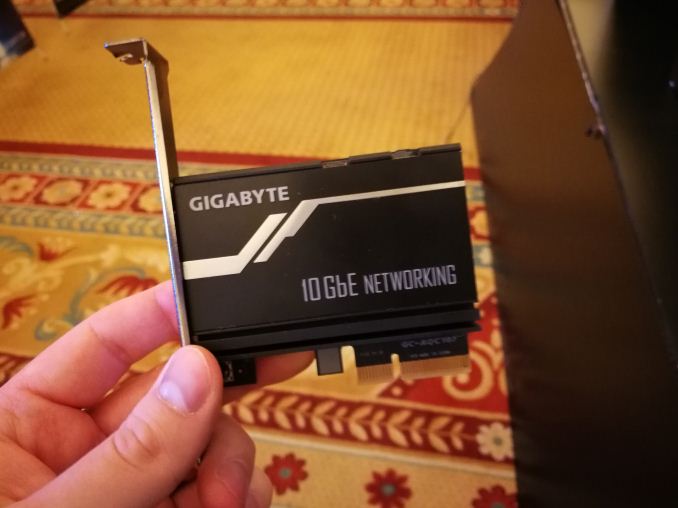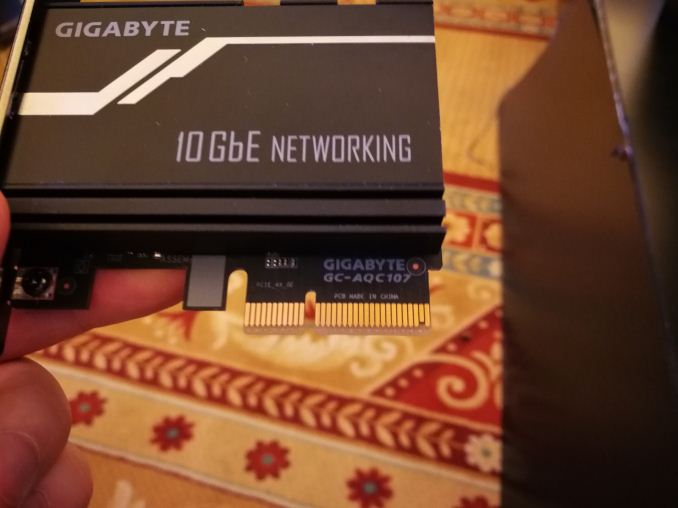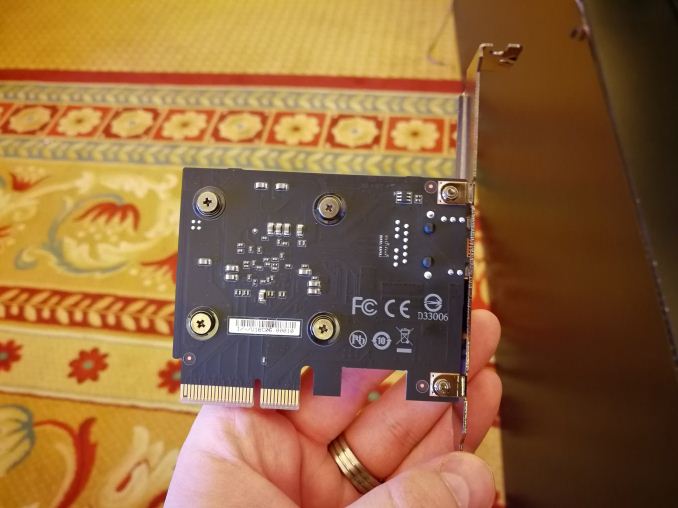GIGABYTE Exhibits an Aquantia AQC107 based 10G Ethernet PCIe Card
by Ian Cutress on January 11, 2017 3:00 PM EST- Posted in
- Networking
- Gigabyte
- 10GBase-T
- Aquantia
- 2.5GBase-T
- 5GBase-T
- PCIe
- RJ-45
- AQC107

During December, Aquantia announced that it will be launching two multi-gigabit NICs into the market, offering 2.5G/5G capability on both and one with 10GBase-T as well. We were told that industry partners would announce solutions with the chips in due course, and on Kaby Lake launch day we saw ASRock announce a pair of motherboards to come with the chips. GIGABYTE is also joining the fray, with a PCIe card to be potentially bundled with future motherboards or offered as a standalone product.
The GIGABYTE solution is a PCIe 3.0 card featuring a single 10G port, which allows for half-height and full-height PCIe slots. Only an AQC107 version was at the show for 10G, and it wasn’t clear if a 2.5G/5G version using the AQC108 would be inbound, but at this point in time GIGABYTE is keeping its cards close to its chest.
Aside from showing it exists, not much else was given – if it will be sold standalone, or what the extra price will be. The interesting thing for us to determine is the BOM cost (bill of materials) for the Aquantia chips – Aquantia has mentioned that they want to undercut 10G solutions significantly, and help drive multi-gigabit ethernet to both the PC and the backhaul of a home or business network. Having PCIe cards you can slot in certainly helps, and we mentioned to GIGABYTE that if this card hits the market in the $80-$100 range for a single port, that would help (and any cheaper would mean it will fly off the shelves).
A big question with multi-gigabit ethernet, especially 2.5G/5G, is the availability of consumer-grade switches and hubs. We might have to wait another 12-18 months for those to come through, and again, pricing is a concern here. Aquantia has said they are working with the major players in that space, but it will be up to them to announce products.
I’ve told GIGABYTE that when the cards are available, I will take a few for testing. I’m slowly building up a sizable stack of 10GBase-T controllers, and we might start looking into relevant networking tests for them for comparisons. Any suggestions, please let us know.
Related Reading:


















25 Comments
View All Comments
eldakka - Thursday, January 12, 2017 - link
If someone's trying to sell you cat6E and you buy it, then I've got a bridge you might be interested in too...There is no defined standard that defines cat6e.
There's (in ascending capabilities order) cat5, 5e, 6 and 6A. There is no 6e.
shelbystripes - Thursday, January 12, 2017 - link
I'm disappointed by the lack of 2.5/5Gb hardware announcements. The industry was building NBASE-T hardware before the 802.3bz standard was announced. Netgear has a pro-level router on the market. Nobody was ready to announce new gear that's coming, even if it isn't available today? What's with that?nowayandnohow - Wednesday, January 18, 2017 - link
why bet money and time on things that run half or quarter speed? Anything you buy with 2.5/5 is a compromise that will no longer be any point to once the chipsets change generation (and on the server side we are almost there). Screw the 2.5&5, gimmi the full 10G instead.doggface - Saturday, January 14, 2017 - link
Hi Ian,My personal use case, would be for a NAS on 10GBE serving multiple clients on 1GBE and WiFi. I'd be curious as to what speed benefit 10GBE would provide in that scenario.
nowayandnohow - Wednesday, January 18, 2017 - link
well, the benefit would basically be 10x the capacity of your GB link today? so easy math, 8 clients with ggabit speed would get 7 x more data and leave 200% of 1GB link still available.Also, have you ever wondered how all these AC Wi-Fi is going to be able to run at "full speed" when the backlink maxes out at 1Gbit? What good does AC1800 do you with a gigabit backend? With a 10GB you could run multiple clients at full duplex transfer and still have plenty of capacity left.